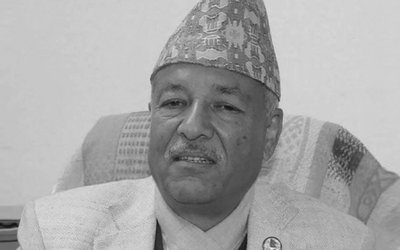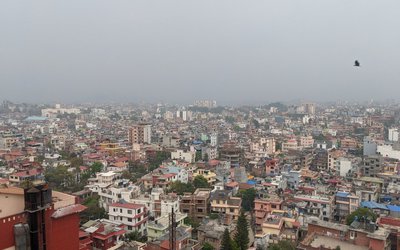
Helicopters hovered around the far west flood affected districts carrying ministers, senior government officials, army chief and local security personnel. They visited the districts to take stock of the situation and distribute cash, clothes and foodstuff to victims as per the government guidelines.
The drama of rescue and rehabilitation has continued for the last many years. However, this method has neither prevented any disaster nor saved many lives and much property. People who survived from disasters and floods, suffered huge financial losses and were coping with trauma and trouble in their whole life.
As Nepal's disaster management is still geared towards rescue and rehabilitation, Nepal Army, Armed Police and Nepal Police are in the frontline, backed by district administration units. In the process of rehabilitation, the role of community is nominal.
Complete disaster prevention is not possible. However, there are means and ways to reduce human casualties and loss of movable property. Practical Action, an INGO working in Nepal with partnership with Department of Hydrology, local level administrative bodies and community for a long period of time, has shown that given a well-equipped and well-managed early warning system, the country can preempt the human losses and damage of movable property.
This is what one could see happening in Bardiya district this year. Even the level of damage, it appeared, could be reduced drastically through the community participation in preventive exercises. Although the flood in Karnali river was at the highest level in 35 years, the preventive measures saved the lives of dozens of people and property worth millions of rupees. Although the flood damaged 326 houses completely and 816 partially, displacing 2,417 families, there was no human casualty and people were able to take away their movable property.
The alert issued by Flood Forecasting Division of Hydrology and Meteorology gave enough time for the local people to move away from the site of possible disaster. Program Coordinator for DRR and Climate Change in Practical Action Dina Nath Bhanadari holds the view that early warning system needs to be develop and expanded in Nepal to prevent human casualties. "This is the only way to prepare for disasters."
According to the Department of Hydrology and Meteorology Flood Forecasting Project, the level of water is normal now but there is a possibility of its increase any time, depending on the rainfall. Flood forecasting project websites issued alerts about the level of water and flood situation every day for the district level officials and the local community, depending on the risk.
Had similar flood forecasting systems been in place, the flood caused by heavy rain on June 16 would not have devastated far-west and mid-west.
However, Nepal is yet to practice the system in various parts. Instead, the government's focus is on traditional approaches like rescue and rehabilitation.
"We have already distributed Rs. 915,000 for families of 30 dead and 2.5 million to the 400 displaced people. The relief package has already been sent to the affected districts,” said Pralhad Pokharel, joint spokesperson of the Ministry of Home Affairs.
Fifty people died following the first disaster, according to the Ministry of Home website, which reports 18 missing, 300 injured, 15,871 houses destroyed completely, 1,496 damaged partially. According to the Ministry of Home Affairs, a total 797 households, with 4,118 people, were displaced. The flood affected 11,393 people all over Nepal. The government has already distributed Rs. 17.5 million as relief.
"The Ministry is distributing relief materials in flood-hit districts in close coordination with the district-based security personnel and government authorities," said spokesperson at the Home Ministry, Shankar Prasad Koirala.
"We are reaching to flood affected areas with needed relief materials," said Lakshmi Prasad Dhakal, chief of National Emergency Operation Centre, which monitors natural disasters in Nepal.
A total of 7,000 people have also been displaced, while 800 houses have been completely destroyed and 1,500 partly damaged, after heavy monsoon rains began in mid-June and eased two weeks later, he said. "Over 1,000 livestock have also been killed and we are still assessing the damage in monetary terms,"
Hundreds of people die every year from flooding and landslides during the monsoon season in Nepal. Nepal is one of the 20 most disaster-prone countries in the world. The data on human mortality for the period 1971-2007 show more than 27,000 deaths, 50,000 injuries, 3,000 missing and approximately 5 million affected. More people are killed by disasters in Nepal than in any other country in South Asia. In addition to the high mortality risk, more than 50,000 people were reported as injured, about 3,000 people missing, and about 5 million people affected during the period 1971- 2007. Nepal is a disaster-prone country mainly due to its young geology, mountainous terrain, and widespread poverty. Major types of disasters in Nepal include floods, earthquakes, droughts, landslides, epidemics, Glacial Lake Outburst Floods, fire, and ecological hazards. Nepal stands at 11th and 30th position in term of earthquake and water induced vulnerabilities respectively in the world.
According to UNDP, flash floods have on average killed 178 people, affected a further 114,000 and caused over US$ 34.5 million worth of damage each year since 1980.
Community Early Warning Systems
At a time when the story of devastation is affecting the life of poor people, the community early Warning System in Nepal is saving human lives.
"On a recent trip to Nepal, I was introduced to Practical Action’s work on flood preparedness and, in particular, the development of Early Warning System to provide poor communities with advance warning of devastating floods," writes Colin McQuistan of Practical Action in the blog.
Recognizing this threat, Practical Action started engaging vulnerable local communities in flood prevention planning from 2002 and it was quickly realized that the major problem was a lack of prior warning. Hence regardless of when the flood struck, the losses were considerable, particularly for the poor and marginalized families that lived in the most vulnerable locations.
So Practical Action approached the Department of Hydrology and Meteorology of the Government of Nepal, with a proposal to link their river monitoring stations, using mobile communications to communities downstream to extend advance warning from a few minutes to at least a couple of hours.
Following the agreement of the department, Practical Action worked with local communications specialists, Real Time Solutions Pvt. Ltd, to link this information to SMS services and also connecting the data to the internet, allowing real time flood warning information to be disseminated to many different users.
This system is now operational in 5 river systems in Nepal, the West Rapti, Narayani, East Rapti, Babai and Karnali Rivers, providing between 1.5 to 5 hours advance warning depending on the river system. This has reduced the flood vulnerability of poor communities living along these rivers and has enabled local authorities to deliver more responsive flood relief.
Community participation is key to successful implementation of projects. "Participation is the key to success in any community based program. Participation can only be guaranteed if communities are fully aware of what is taking place and are involved in the decision making processes. As such, Practical Action carried out extensive consultative processes both before and during the program," said Upendra Shrestha, head of program funding and communication, Practical Action.
Communities were left alone to decide their committee make-up, though the inclusion on the "VDC Secretary", the lowest level government representative, on the committee, where this post existed, was felt to be appropriate, so as to include the government from day one. Committees had very few female members in most cases, though over the course of the program as members have left or dropped out and been replaced, the number has increased significantly. It is not by chance that the community with the highest number of female committee members is also the community with the highest levels of participation and community contribution.
"Practical Action in Nepal is demonstrating various approaches to strengthen community’s coping capacities with impacts of climate change. The community based adaptation approach implemented by Practical Action along with the local authorities is mainly focusing interventions in – a) natural resource management for reducing climate change effects; b) adaptation to changing farming systems and practices; c) strengthening coping strategies of the communities and enhancing complementary livelihood options; and d) establishing the monitoring systems of climate change at the community level considering the social, economic and natural resource parameters," said Shrestha.
However, the government officials see this alone is not enough. Early warning system is good to prevent loss and casualty.
“Nepal government is also implementing the Early Warning System nation-wide," said Koirala. "Till the expansion and development of such system, there is no way other than to go for reconstruction and rehabilitation.

Keshab Poudel
Poudel is the editor of New Spotlight Magazine.
- FM Dr. Deuba’s India Visit: Mission Aborted
- Mar 26, 2025
- AMBASSADOR MAEDA TORU: Warm Regards
- Mar 24, 2025
- PRO-MONARCHY MOVEMENT: Rising Dissatisfaction
- Mar 23, 2025
- Dr. PRABIN MANANDHAR: Person With Humility
- Mar 16, 2025
- US SUSPESION OF GRANT: Impact On Nepal
- Mar 10, 2025















